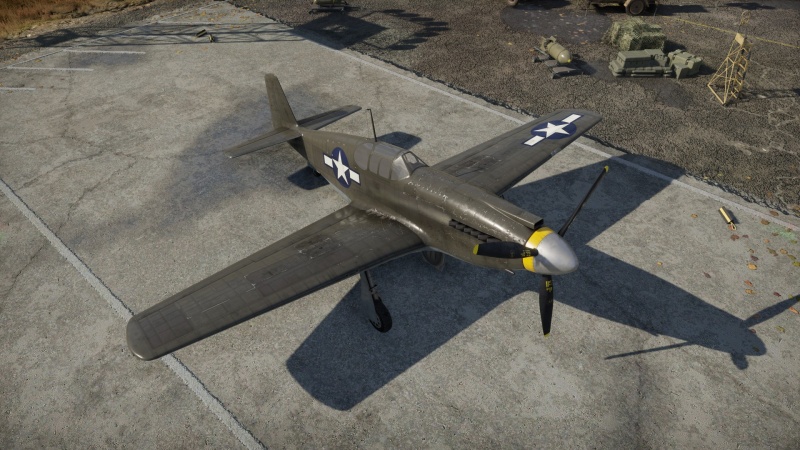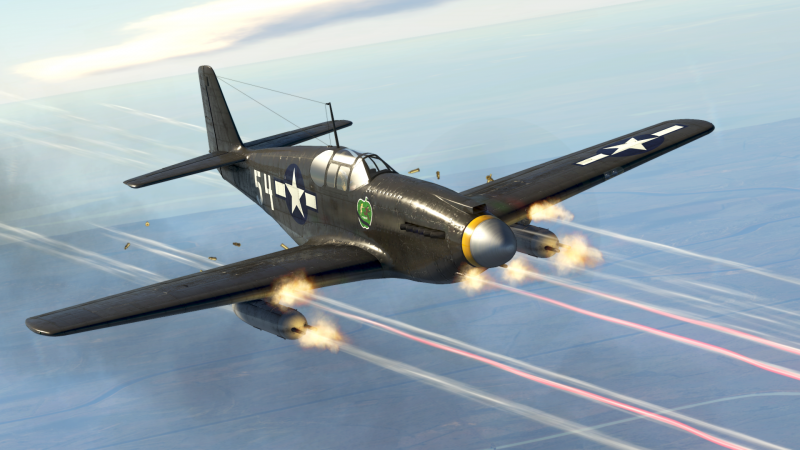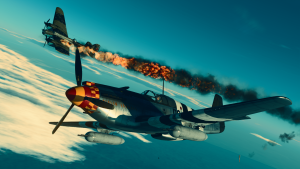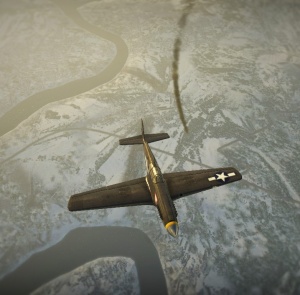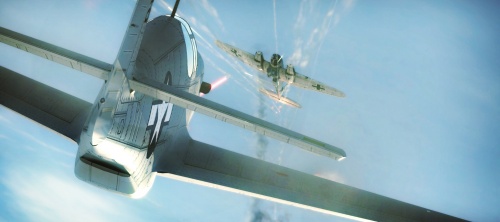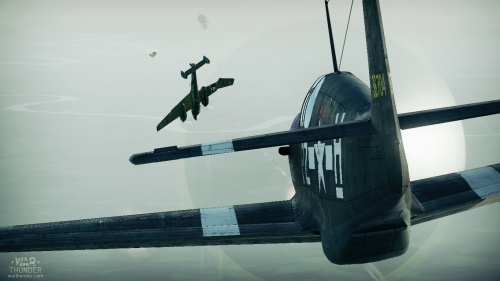A-36
Contents
Description
North American Aviation Company was busy during 1942 building and shipping Mustang Mk.I fighters to England to be incorporated into the Royal Air Force to fight alongside the Curtiss P-40 Tomahawks. Unfortunately for England, lend-lease funds ran out, and 93 unshipped Mustang IA/P-51s went to the US Army Air Forces. North American did not want to stop production of the P-51s and pressured the USAAF for a fighter contract. Unfortunately, for the fiscal year 1942, no government funds were available for new fighter aircraft. However, when it was observed that attack aircraft funds were available, North American reconfigured the Mustang into a dive bomber, outfitting it with heavier wings, bomb racks, and dive brakes. With this dive bomber/attack variant approved for manufacturing, NAA ramped up production and cranked out 500 A-36A aircraft, which saw use in the Mediterranean and China-Burma-India theater.
Introduced in Update 1.51 "Cold Steel", the A-36, as an early war multi-role aircraft, can suit the play-style of just about any pilot and can be reconfigured to accommodate different maps and missions. Outfitted with the Allison V-1710-87 inline water-cooled engine, the plane suffers in high-altitude flying; however, for lower altitude dive-bombing, this engine performed quite well. High enough speeds could be developed in a dive to rip the wings, so dive brakes were implemented to regulate the dive speed to around 630 km/h (390 mph). Maintaining speed in a dive ensures enough energy is available to zoom climb back up to altitude or to get away from any enemy fighters which may have attempted to intercept you. Depending on the map, the dive bomber can convert to a strafing aircraft once the bombs are released. With six internal 12.7 mm machine guns and four more possible mounted in gunpods, softer ground targets and other aircraft are no match and will be easy pickings.
General info
Flight performance
The A-36's performance varies a lot depending on the external armaments carried. It's very sluggish with the 4 x 12.7 mm M2 Brownings in gunpods, and the more kg of bombs it carries the worse the performance gets. Without anything on the wings it has a great acceleration, decent turn time and can withstand from 11 to -5 G.
| Characteristics | Max Speed (km/h at 1,760 m) |
Max altitude (metres) |
Turn time (seconds) |
Rate of climb (metres/second) |
Take-off run (metres) | |||
|---|---|---|---|---|---|---|---|---|
| AB | RB | AB | RB | AB | RB | |||
| Stock | 556 | 542 | 23.4 | 24.2 | 9.7 | 9.7 | 400 | |
| Upgraded | 621 | 589 | 21.3 | 22.3 | 17.4 | 13.1 | ||
Details
| Features | ||||
|---|---|---|---|---|
| Combat flaps | Take-off flaps | Landing flaps | Air brakes | Arrestor gear |
| ✓ | ✓ | ✓ | ✓ | X |
| Limits | ||||||
|---|---|---|---|---|---|---|
| Wings (km/h) | Gear (km/h) | Flaps (km/h) | Max Static G | |||
| Combat | Take-off | Landing | + | - | ||
| 650 | 520 | 279 | ~12 | ~6 | ||
| Optimal velocities (km/h) | |||
|---|---|---|---|
| Ailerons | Rudder | Elevators | Radiator |
| < 550 | < 230 | < 550 | > 360 |
| Compressor (RB/SB) | ||
|---|---|---|
| Setting 1 | ||
| Optimal altitude | 100% Engine power | WEP Engine power |
| 762 m | 1,325 hp | 1,500 hp |
Survivability and armour
- Protective plates and glass
- 38 mm Bulletproof glass in front of the pilot
- 11.11 mm Steel plate behind the pilot
- 6.35 mm Steel plate in front of the engine
- 6.35 mm Steel plate between engine and pilot
The A-36's armour configuration does a decent job of protecting the pilot, especially in frontal or head-on attacks. From behind the pilot's seat backs up to an 11.11 mm steel plate, however from the front, the canopy windscreen contains 38 mm bulletproof glass. There is also a 6.35 mm steel plate both in front of the engine and behind it between the engine and the cockpit. To get to the pilot, bullets from the front will need to pass through the first plate, the engine and then the second plate. The chances are the engine will be disabled before the pilot is knocked out in a head-on attack. The front-most steel plate will help to protect the engine from smaller calibre machine gun fire, however, it does not fare so well once you start going against +20 mm rounds which have a greater punch.
Keep up speed and manoeuvrability which will make it difficult for any enemy fighter to get a bead on you and the different steel plates should do their job in protecting the fighter from stray bullets. The A-36 when outfitted with gun pods can become an absolute terror especially during head-on attacks, however, don't think that just because of the armour in the aircraft, you are fine. Remember when performing head-on or diving attacks on bombers fire off rounds and then manoeuvre as bullets headed your way in which you fly into will have a greater impact, it is imperative to move out of their way rather than take a chance and hope that a 6.35 mm steel plate will fully protect the engine or the pilot.
Modifications and economy
Armaments
Offensive armament
The A-36 is armed with:
- 2 x 12.7 mm Browning M2 machine guns, chin-mounted (300 rpg = 600 total)
- 4 x 12.7 mm Browning M2 machine guns, wing-mounted (350 rpg = 1,400 total)
The A-36 is outfitted with six 12.7 mm Browning M2 machine guns, the good thing about this is that they are all the same type of gun and will all have the same amount of bullet-drop, making it easier to predict where the rounds will end up, the unfortunate thing is that two are mounted in the nose while two others are mounted in each wing. The unfortunate part of this is that the pilot now has to consider setting the convergence range to help make the shots more effective. Setting them too close or too far from the range the pilot typically shoots from will most likely guarantee some rounds will miss due to the over/under correction. A good middle range to configure for will be 400 m as this doesn't require the pilot to follow too close behind, but the bullets still have a bit of punch, however for those pilots which take the fight in closer, a convergence of 200-300 m will concentrate all the rounds into a tight sphere with a solid kick usually dismantling critical components from the aircraft under target.
Suspended armament
The A-36 can be outfitted with the following ordnance:
- Without load
- 2 x 100 lb AN-M30A1 bombs (200 lb total)
- 2 x 250 lb AN-M57 bombs (500 lb total)
- 2 x 500 lb AN-M64A1 bombs (1,000 lb total)
- 4 x 12.7 mm Browning M2 machine guns, wing-mounted (340 rpg = 1,360 total)
Though not what one would typically consider a dive bomber, the A-36 does make a really effective attack aircraft outfitted with 100, 250 or 500 lb bombs. Whereas larger attackers and bombers are typically slow and clumsy when it comes to aiming for a target, the Apache is the opposite and actually a pioneer for later fast, small, single-pilot aircraft to take on this role. The Apache is relatively comfortable at flying at 12,000 ft (3,660 m) or at tree-top level, however, it does excel when it comes to dive-bombing. Though the larger the bombs it carries, the less manoeuvrability it has, that doesn't matter when it comes to diving on the target, here the only critical issue is not building up too much speed as the wing load can only take so much before the wings snap off. Typically the best method is to approach the target in a dive at about 70° and starting from about 10,000 – 12,000 ft ( 3,040 – 3,660 m), deploy dive brakes and line up for the target. When between 2,000 – 4,000 ft (610 – 1,220 m) release bombs, retract dive brakes, full throttle and pull up in a zoom climb.
The smaller 100 and 250 lb bombs are good for lightly armoured targets such as anti-aircraft cannons, trucks and light tanks. The 500 lb bombs should be reserved for more heavily armoured targets such as pillboxes, medium and heavy tanks or even many targets clustered close together. Though bases could be bombed, these bombs are relatively ineffective, however in a pinch, if all of the other smaller targets have been destroyed, feel free to drop bombs on bases to help rack up some points for ordnance dropped.
For those pilots who don't have the patience for bombing runs and just want to tear up the playing field with machine guns, the DGP-1 gun pods will be the suspended weapon of choice. Extending the aircraft's already six .50 calibre machine guns to 10 is enough do some serious damage both in the air and on the ground. The pilot will need to set the convergence to a comfortable distance which suites their needs, however, for those which like to get in close to other aircraft, setting convergence from 200-300 m will allow the ten guns to focus their rounds typically blowing off a wing, the aircraft in half or just pelting the critical components into failure. For those which will use the gun pods for ground-attack, having the convergence a bit farther out, say 500 – 600 m will allow for manoeuvring around the terrain and position for success rather than having to be right on top of the target before you can get a clean shot. The gun pods also allow the pilot to switch up tactics mid-match to air attack or ground attack and even switch back depending on target availability.
Usage in battles
The A-36 is quite a unique aircraft for its rank. It is a sleek looking fighter-bomber and should be used as such. It has good speed for its rank and designation, decent armament and a good selection of payloads; the A-36's role varies depending on the game mode you play.
Air Arcade and Air Realistic - In air battles, you can target ground forces with your .50 cals, equip bombs and take out medium or heavy tanks. One thing to remember while ground-pounding, enemy aircraft will see you as a tempting target which might cause you to prematurely release your ordnance and then fight as a fighter instead. For a slight performance drop, you can equip the gun pods, which makes this plane absolutely formidable against any aircraft, especially during head-on attacks. Fighters and bombers alike will take heavy damage if not fully destroyed by the ten .50 calibre machine guns. Generally, it is best to focus on enemy aircraft in Air Arcade, while leaving the ground attack to more dedicated aircraft.
Ground Realistic - Ground RB allows you to really let the A-36 shine. It performs very well in the fighter-bomber role. If you equip bombs, you can quickly dive into battle, bomb a target and then begin engaging enemy aircraft. If you instead equip the gun pods, you should also equip the ground targets belt. The high amount of AP ammunition allows you to penetrate most German and Japanese vehicles through the roof, while the belt still retains high levels of effectiveness against aircraft, allowing you to be a true multi-role fighter bomber. The gun pods also allow you to hunt heavily armoured aircraft like the IL-2.
Tip: taking off in Simulator Battles
Sea-level maximum speed (Auto engine control, no secondary weapons): Altitude: just above sea level (minimum safe altitude: 5m/16ft), 100% throttle, elevator trim: 4% up, aileron trim: 1% left, rudder trim: 0%, you should get a true airspeed of 523 km/h (325 mph/282 kt). Maximum true speed (Auto engine control, no secondary weapons): Altitude: 1,760 m/5,775 ft, 100% throttle, elevator trim: 5% up, aileron trim: 1% left, rudder trim: 0%, you should get a true airspeed of 536 km/h (333 mph/289 kt).
Manual Engine Control
| MEC elements | ||||||
|---|---|---|---|---|---|---|
| Mixer | Pitch | Radiator | Supercharger | Turbocharger | ||
| Oil | Water | Type | ||||
| Not controllable | Controllable Auto control available |
Not controllable Not auto controlled |
Controllable Auto control available |
Combined | Not controllable 1 gear |
Not controllable |
Pros and cons
Pros:
- Overall good flight performance
- Highly agile for an attacker, especially at high speed (being based on the P-51)
- Very good energy retention for an attacker
- Good performance at low altitude
- Very good dive speed and acceleration, excels at boom-and-zoom tactics
- Has air brakes, useful for dive bombing and landing
- Powerful armament
- Equipped with 6 x M2 12.7 mm machine guns with an access to the dreaded API belts
- Superior firepower compared to other planes at its rank
- Can equip 2 x DGP-1 gunpods, adding further 4 x 12.7 mm M2s to its armament (10 in total), giving the A-36 a very high burst-mass comparable to the F-82E
- Fast bomb reload unlike typical strike aircraft in Arcade
- Attacker spawn point, can be used to certain advantage
- Remains effective even against enemy from higher BRs
Cons:
- Fuselage mounted M2s are hooked up to a synchronizer, lowering their effective rate of fire (prevents them from shredding the propeller)
- Is not a dedicated attacker unlike the A-20G-25
- Will be out-turned by most fighters of other nations, especially at lower speeds and when stock
- Mediocre rate of climb, horrible when stock
- Engine power suffers greatly at high altitude, reducing to ~1,000hp at 4,000m compared to 1,500hp at 762m, greatly diminishing rate of climb at higher altitudes
- Does not have access to rockets or bombs over 500 lb, making it difficult to use against heavily armoured targets
History
The A-36 Apache, also referred to as Mustang, was a ground attack variant of the P-51 Mustang. In 1942, the Mustang I began to see service with the Royal Air Force and saw its first combat. It performed well, and North American Aviation wanted to get a contract to produce it for the USAAF, but there was no funding for fighter contracts in 1942. Instead, they decided to market it as an attack aircraft, as there were contracts available. They modified the Mustang to make it a dive-bomber, and designated it the A-36 Apache. Bomb racks and dive brakes were added, and the wings were strengthened.
The A-36 Apache first saw service in North Africa, and after several issues were noticed, pilots began to learn the proper dive-bombing technique. Once it was used properly by experienced pilots, the A-36 became known as a very reliable and consistent aircraft. The A-36 was also used extensively in the Sicily Campaign. They were used to take out enemy gun positions and strong points as the Allied armies advanced. A-36s not only performed well in ground attack, but also in dogfights. The A-36 scored 84 aerial victories. As the fighting in Italy got fiercer, the A-36 began to face alarming casualties. This was in part because of missions that placed them against deadly ground fire, and the Germans would run cables across hilltops in order to snag A-36s out of the air.
By June 1944, the A-36 was replaced in Europe by more effective models, such as the P-47 Thunderbolt and P-40 Warhawk. The A-36 also served in the China-India-Burma theater, at a great disadvantage. It performed long range missions of reconnaissance, dive bombing, attack, and fighter missions. Its main opponent was the Japanese Nakajima Ki-43, which outclassed the A-36 completely. It was gradually phased out of service since 1944, with some being used as training aircraft. Although it was only produced in small numbers (around 500) and served only for a short time, the A-36 made significant contributions to the American war effort. Notably, it was the first P-51 Mustang variant to enter combat with the USAAF.
Media
- Skins
See also
- Related development
External links
| North American Aviation | |
|---|---|
| Fighters | |
| P-51A | P-51 · P-51A |
| P-51C | P-51C-10 |
| P-51D | P-51D-5 · P-51D-10 · P-51D-20-NA · P-51D-30 |
| P-51H | P-51H-5-NA |
| Twin-engine fighters | F-82E |
| Jet fighters | F-86A-5 · F-86F-2 · F-86F-25 · F-86F-35 · F-100D |
| Strike aircraft | A-36 · PBJ-1H · PBJ-1J |
| FJ-4B · FJ-4B VMF-232 | |
| Bombers | B-25J-1 · B-25J-20 |
| Export/Licence | ▂B-25J-30 · ␗B-25J-30 |
| ▄Mustang Mk IA · F-6C-10-NA · ␗P-51C-11-NT · ␗P-51D-20 · J26 David · J26 · P-51D-20-NA · ␗P-51K | |
| F-86F-30 ▅ · ␗F-86F-30 · F-86F-40 ▅ · F-86F-40 JASDF▅ · ␗F-86F-40 | |
| ◄F-86K · ▄F-86K (Italy) · ▄F-86K (France) | |
| ␗F-100A · ▄F-100D · ␗F-100F | |
| Captured | ▅P-51C-11-NT |
| Canadair Limited license-built the F-86 as the CL-13 for use in Canada and export to Europe. | |
| Fiat license-built the F-86K for the Italian Air Force though another 120 NAA built F-86Ks were also sold to the Italians. | |
| See Also | Mitsubishi Heavy Industries · Canadair Limited · Fiat Aviation |
| USA strike aircraft | |
|---|---|
| Douglas | A-20G-25 · A-26B-10 · A-26B-50 · A2D-1 · AD-2 · AD-4 · A-1H |
| North American | A-36 · PBJ-1H · PBJ-1J |
| Other | AM-1 · AU-1 · XA-38 |



